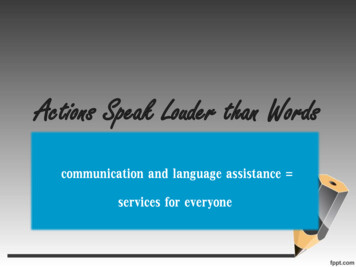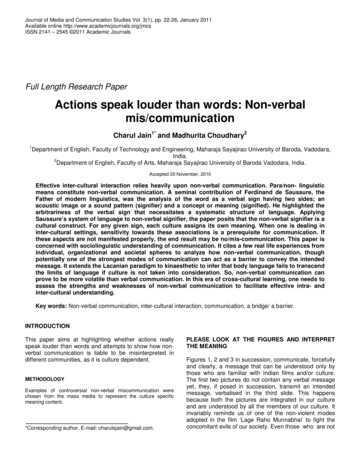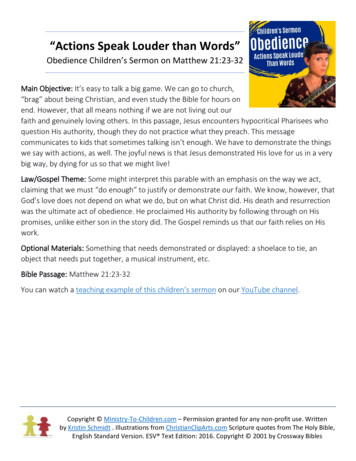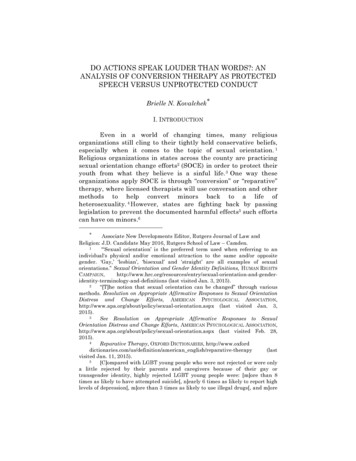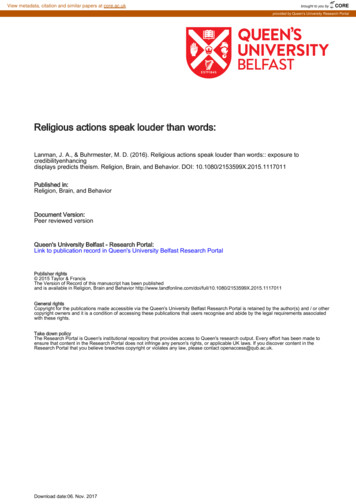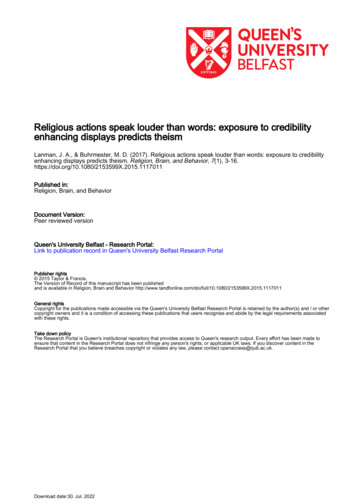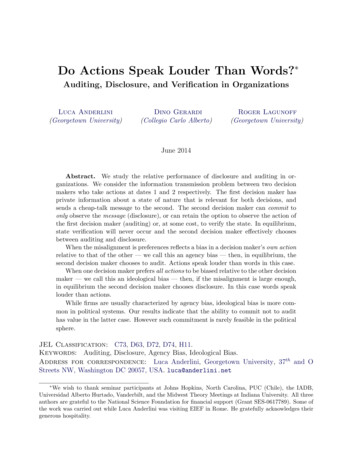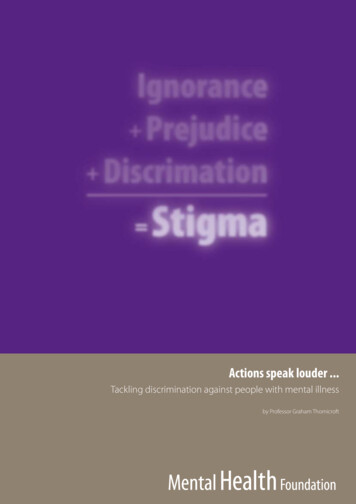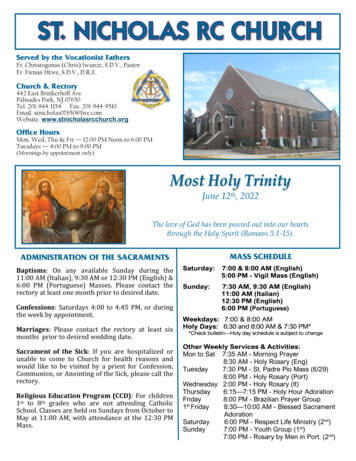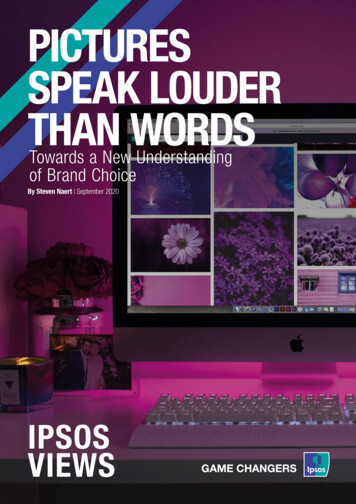
Transcription
PICTURESSPEAK LOUDERTHAN WORDSTowards a New Understandingof Brand ChoiceBy Steven Naert September 2020IPSOSVIEWS
LEVERAGING VISUAL METAPHORSBrand managers are faced with a wide array of businessthinking. We ask respondents to react to a set of pictures, withchallenges: How can I better position my brand?each picture implying a range of specific values or emotionalHow can I optimize my portfolio? Where can I findbenefits. Because people easily recognize these values, thesenew growth opportunities?pictures make it easy for people to express themselves in a moreintuitive way. By capturing spontaneous reactions to visual cues,Traditional quantitative research has relied heavily on statedmarketers can gain a deeper understanding of feelings, moods,responses, often using long and redundant lists of attributes.and emotional experiences – and thereby make decisions basedWhile there is still room for this kind of measurement, it doeson fundamental consumer needs. Moreover, the use of imagesnot adequately capture people’s less conscious needs. People’sis more engaging to respondents than traditional questions anddecision making is often influenced by their intuition; therefore,more aligned to the visual culture in which we now live.it is important that we capture less conscious desires as well asthe mental shortcuts people use when making brand decisions.HOW IT WORKSTo evolve the traditional survey to capture non-consciousUsing a device agnostic survey, respondents first scrolldecision-making, we have developed a new metaphorthrough the set of pictures using an interface which lookselicitation technique to uncover implicit brand choicelike an Instagram feed. First, we ask respondents toinfluencers. While metaphor elicitation has been used as aselect up to five pictures to help them express how theyqualitative technique for many years, the approach we havefeel about a product in a given situation. For instance, wedeveloped uses a quantitative method – making metaphormay ask them to select five pictures that express whatelicitation efficient, scalable, and accessible.they expect from having a snack in front of the TV or goingon a family holiday. Next, we ask respondents to explainOur metaphor elicitation approach connects us to consumerswhat these pictures represent for them. In total, these twothrough visual images and natural conversations, using aquestions typically take less than two minutes to complete.projective technique that helps respondents avoid rational(See Figure 1.)Figure 1 How it worksStep 1: Scrollthrough up to200 picturesCarrier9:41 AMstaging01.ipsosinteractive.comPictures which represent your idealPocket fruity sweets or mintswhile chatting with others“Scroll through thesepictures and select 5that express what youwere looking for in theproduct you had. Don’tthink too much about it,follow your intuition!”2IPSOS VIEWS PICTURES SPEAK LOUDER THAN WORDSStep 2:Interpretthe visuals“What kinds of feelings,moods, and emotionalexperiences do theyrepresent?”Can you please describe in your ownwords what these pictures mean;how do they represent what youideally were looking for the last timeyou consumed pocket candy whilechatting with othersType here
POSITIVE VS. NEGATIVE PICTURESWe approach visual metaphors from two directions – positiveNegative Picturesand negative – depending on the business challenge.If the business challenge is to learn how to meet unmetneeds or barriers – in other words, to uncover what peoplePositive Picturesfind frustrating and challenging and are not getting out ofIf the business challenge is to optimize the brand portfoliocurrent brands – we use a collection of pictures (again 200)or brand positioning, fulfill consumers’ current and knownthat imply negative feelings (e.g., pictures of yawning, timeneeds, or find white space opportunities – in other words,pressure, chains). (See Figure 2.)to uncover what people want from a brand – we use acollection of pictures (200 in total) that imply positivefeelings (e.g., pictures of a baby, flowers, the NorthernLights). (See Figure 2.)NEGATIVE PICTURESPOSITIVE PICTURESFigure 2 Positive and negative picturesPICTURES SPEAK LOUDER THAN WORDS IPSOS VIEWS3
HOW WE CHOSE THE PICTURESSTRUCTURINGUNSTRUCTURED DATAWe used a systematic approach to choose the picturesstarting from a list of intended meanings covering 150The open-ended question we ask about what the picturesdifferent values (e.g., thrill, harmony, obedience). This listrepresent produces a vast amount of unstructured data.was inspired by existing value scales developed by the likesTherefore, we need an efficient and accurate way to analyze it.of Milton Rokeach1, Steven Reiss 2 and Shalom H. Schwartz 3.We then enriched this list with values from our own needsSo, how do we analyze this unstructured information?and motivations research experience.First, we translate the data into the base language usingOnce our list of values was complete, we selected pictures toan automated process. We then leverage advanced textrepresent each of the values on the list. The bank of picturesanalytics to extract key themes (the main verbal constructscan be used across the globe – with visual metaphor studiespeople associate with each picture). Next, we review the keyalready conducted in 20 markets across Africa, Asia, Europe,themes from the text analytics in conjunction with the visualsthe Americas and the Middle East.themselves and make any adjustments. Finally, we conducta factor analysis and cross the factors with segments,As we expose respondents to over 150 values totarget groups, or occasions. Armed with this information,spontaneously react to, our metaphor elicitation approachwe can define your brand’s role (how they can be relevantgenerates more granular and specific insights thanto people’s lives) and use these roles as a springboard totraditional approaches that feed respondents a list ofdevelop platforms that capture potential future directions fordefined attributes.your brand. (See Figure 3.)Figure 3Translateconsumergeneratedopen-enddata4Extractkey themesIPSOS VIEWS PICTURES SPEAK LOUDER THAN WORDSConductfactoranalysisCross withsegments,target groupsor occasionsDefineroles
PICTURES SPEAK LOUDER THAN WORDS IPSOS VIEWS5
METAPHOR ELICITATION IN ACTIONMetaphor elicitation adds a new and powerful dimensionOur metaphor elicitation approach grouped women into sixto segmentation, brand portfolio optimization, brandconsumer segments. We found each of these segments, inpositioning, and white space identification.greater and lesser proportions, across China, Japan andKorea. Figure 4 illustrates just one of the segment profilesA recent example of metaphor elicitation is a study wethat was created using our metaphor elicitation approach.conducted to gain a deeper understanding of the AsianBased on just two survey questions (Which five picturesbeauty market. Our focus was on women in China, Japanexpress what you are looking for in a product? and Whatand Korea as these women influence beauty consumerskinds of feelings, moods, and emotional experiences doacross the rest of Asia and around the world. To capture thethose pictures represent? ), we were able to:diversity and the commonalities across beauty consumersin these three countries, we used metaphor elicitation to conduct a segmentation analysis. Our overarching questionDevelop platforms (specific, granularexpressions of a general need)was: What is the experience of being a woman today inChina, Japan, and Korea – their aspirations, motivations, Identify values Uncover the rich and real language that consumersstruggles, and triumphs?use when talking about the category6NEEDSPLATFORMThe real beauty comes from theway you experience lifeGreat career as a meansto achieving independenceand life balanceYearning for independence inthinking and being on one’s ownVALUESHealthy body suppleness firm spirit independence enjoyment pleasure beauty new experiences individualityBusiness success harmoniouslife recognition hardworking knowledge balance travel financial freedomFree spirit self-reliant independence cheerful colorful life creation self-loveEXPRESSIONSFigure 4 The Striver Segment“A woman who has her ownindividuality and has a job, evenif it is hard, and takes care ofher health while exercising andcaring about her relationshipswith friends. She has her ownbeauty.”“On the one hand, I can takegood care of my family and makemy family happy. On the otherhand, I can handle the work well,and I can do some things I likewhen I am free.”“(.) I can stand on my own.Doing what I want to do is tobe confident (.). And I chosea picture that looks free. It wasnot artificially made, but rathernatural from the world, (.) itwas the way women should go.”IPSOS VIEWS PICTURES SPEAK LOUDER THAN WORDS
GETTING TO DEEPER HUMAN MOTIVATIONSWITH METAPHOR ELICITATIONWe recommend leveraging metaphor elicitation to capturethat reflects how consumers (in their own language) reallyimportant implicit drivers of brand choice. Because metaphorthink and feel about products and brands. By getting a truerelicitation uses a projective technique, it helps respondentsconsumer-centric measure of influence, marketers can betteravoid over-rationalization and provides more intuitiveposition their brands, optimize their portfolios and uncoverresponses. Moreover, it generates a deeper, more granularinnovation opportunities.understanding of emotional benefits and provides rich dataREFERENCES1. Rokeach, Milton (1968). Beliefs, attitudes, and values:A theory of organization and change. San Francisco,CA: Jossey-Bass.2. Reiss, Steven (2001). Who am I? The 16 Basic DesiresThat Motivate Our Actions and Define Our Personalities3. Schwartz, Shalom H. (2012). An Overview of theSchwartz Theory of Basic Values. Online Readingsin Psychology and Culture.PICTURES SPEAK LOUDER THAN WORDS IPSOS VIEWS7
PICTURES SPEAKLOUDER THAN WORDSSteven Naert Global Solutions Leader, Market Strategy & Understanding, IpsosThe Ipsos Views whitepapers are produced by theIpsos Knowledge Centre.www.ipsos.com@Ipsos
needs or barriers - in other words, to uncover what people find frustrating and challenging and are not getting out of current brands - we use a collection of pictures (again 200) that imply negative feelings (e.g., pictures of yawning, time pressure, chains). (See Figure 2.) PICTURES SPEAK LOUDER THAN WORDS IPSOS VIEWS 3
